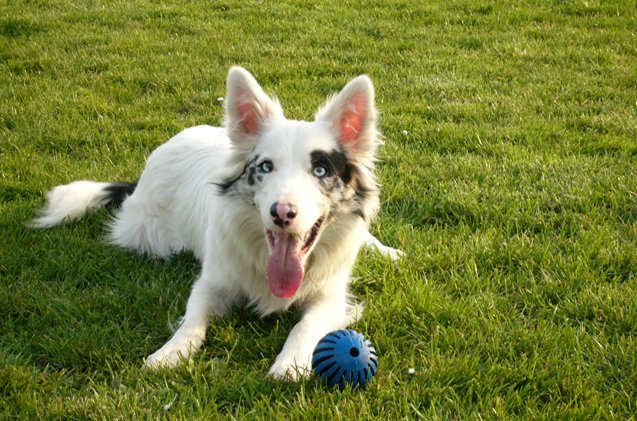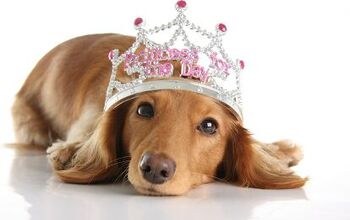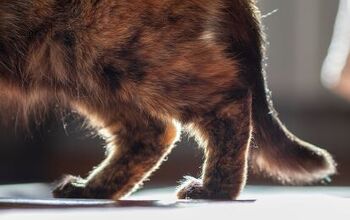What is a Double Merle Dog?

Genetics can be complicated and difficult to understand, but it is an important thing to think about if you are planning to breed dogs – especially dogs of certain breeds where specific genetic combinations can lead to serious health problems. One of the most dangerous genetic combinations for dogs is the “double merle”.
What is a Merle Dog?
The word “merle” describes a color pattern seen in certain breeds of dog. The best example of the merle coloration is the typical blue merle coloring often seen in Australian Shepherds. The typical presentation of the merle pattern is a solid-color coat (usually black) broken up with irregular patches of another color (often gray). No two dogs with merle coloration look alike. The merle pattern can affect dogs of all coat colors and the coloration affects more than just the pattern of the coat – it also affects the coloring of the eyes and may affect the pigment of the dog’s skin as well. The genetic modifications caused by the merle gene are random, so a merle dog may end up with two different colored eyes or mottled pink-and-black pigmentation on the nose and the pads of the paws.
Related: Researchers Say DNA Testing In Pedigree Dogs Not Enough
The Basics of Double Merle Genetics
The merle gene is a heterozygote of an incompletely dominant gene – a dog only needs one copy of the merle gene to exhibit merle coloration. The term “double merle” refers to a dog with two copies of the merle gene. When a dog has two copies of the gene, the effects of the genetic modifications are doubled. Instead of the coat being partially lightened with patches of lighter color, most of the coat turns white. Double merle puppies are born when the parents are both merles – it doesn’t matter what color or breed they are as long as they have the merle gene.
Related: What You Need To Know About Glaucoma In Dogs
Why is Double Merle Genetics Dangerous?
While dogs with double merle coloration are unique and beautiful in appearance, they have an increased risk for certain health problems. In many cases, double merle dogs are born deaf, especially if the added white pigmentation affects the dog’s inner ear. Eye defects are also common in double merle dogs – some canines are even affected by multiple eye defects. Some of the most common eye defects affecting double merle dogs include:
- Irregularly shaped pupils
- Increased sensitivity to light
- Subluxation of the pupil
- Microphthalmia (abnormally small eye)
- Partial or total vision loss
Double merle dogs that have eye defects may experience some level of vision loss, occasionally to the point of total blindness. If a dog has an eye defect but its vision is stable, however, his vision will probably not change as the dog ages unless there is another condition at play. Some of the dog breeds most likely to carry the merle gene include American Pit Bull Terriers, Australian Shepherds, Border Collies, Cardigan Welsh Corgis, Chihuahuas, Collies, Dachshunds, Great Danes, Pomeranians, Shetland Sheepdogs, and mixed breeds.
Because there is such a high risk for eye defects in double merle dogs, it is important that breeders use caution when breeding dogs with the merle gene. The UK Kennel Club has recognized the associated risks and, in 2013, stopped allowing registration for puppies from merle-to-merle matings in order to discourage the practice. If you end up with a double merle dog you may have to make some accommodations for deafness or loss of vision but merle genetics do not affect the temperament of the breed – your dog will be just as lovable as any other. If you are considering breeding your own dog, just be sure to do your research beforehand to avoid merle-to-merle breeding.

Kate Barrington is the loving owner of two cats (Bagel and Munchkin) and a noisy herd of guinea pigs. Having grown up with golden retrievers, Kate has a great deal of experience with dogs but labels herself a lover of all pets. Having received a Bachelor's degree in English, Kate has combined her love for pets and her passion for writing to create her own freelance writing business, specializing in the pet niche.
More by Kate Barrington























